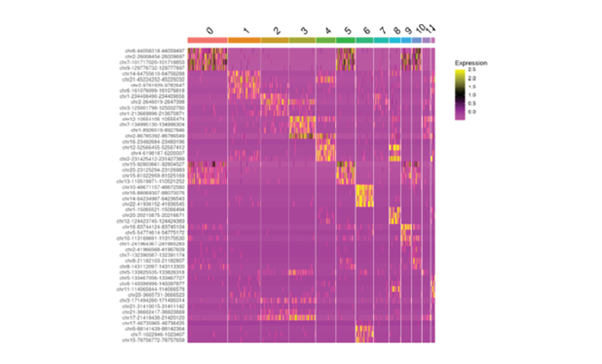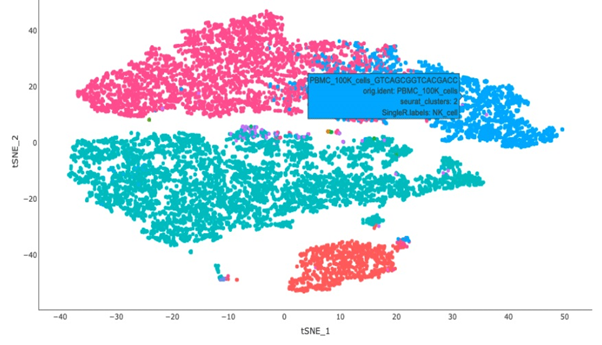By MedGenome Scientific affairs
Bioinformatics plays a vital role in analyzing complex high-throughput sequencing data, particularly in the realm of single cell research. The ability to analyze and interpret massive amounts of single cell data has revolutionized our understanding of cellular heterogeneity and its implications in various biological processes. The blog explores the capabilities of bioinformatics team at MedGenome in analyzing single cell sequencing data. Here, we explore different types of bioinformatics reports, the importance of data visualization and generation of interactive reports such as differential gene expression analysis, heatmap visualization, interactive tSNE plots with cell type and cluster information.
Types of Bioinformatics Reports
In the realm of single cell analysis, bioinformatics reports play a pivotal role in summarizing and presenting the findings derived from complex datasets. There are several types of bioinformatics reports commonly used in single cell research, each serving a unique purpose.
- 1. Cell Type Identification Report: Cell phenotype and its function is determined by gene expression repertoire. Single cell transcriptome profiling is best suited for determining cell type composition of different tissues and also to identify relative proportion of different cell types. This report focuses on the identification and categorization of different cell types within a given dataset. It utilizes unsupervised clustering algorithms to assign cells to distinct clusters based on their gene expression profiles. The report provides insights into the composition and heterogeneity of the sample.
- 2. Cell State Analysis Report: This report aims to uncover the different cellular states within a cell type. It utilizes dimensionality reduction techniques such as principal component analysis (PCA) or t-distributed stochastic neighbor embedding (tSNE) to visualize the variation in gene expression across cells. By identifying different cellular states, researchers can gain insights into cell fate determination, cell differentiation, and cellular plasticity.
- 3. Cell-Cell Interaction Analysis Report: This report focuses on deciphering the interactions between different cell types within a tissue or organism. It utilizes network analysis algorithms to infer the communication networks and regulatory relationships between cells. By understanding cell-cell interactions, researchers can unravel the mechanisms underlying tissue development, immune response, and disease progression.
Data Visualization and Interactive Reports
In the realm of single cell research, data visualization plays a pivotal role in unraveling the hidden patterns and structures within complex datasets. It allows for a comprehensive understanding of cellular heterogeneity and facilitates the interpretation of biological phenomena.
Data visualization tools in bioinformatics enable researchers to create interactive reports that provide a dynamic and intuitive representation of single cell data. These interactive reports allow users to explore the data at different levels of granularity, visualize gene expression patterns, perform differential gene expression analysis, and even interact with individual cells.
By leveraging advanced data visualization techniques, such as scatter plots, heatmaps, and bar plots, researchers can gain valuable insights into the relationships between cells, identify key genes or pathways associated with specific cell states or cell types, and even discover novel cellular subpopulations.
Differential Gene Expression and Heatmap Visualization
Differential gene expression analysis is a powerful bioinformatics technique used to identify differentially expressed genes between different groups of cells or conditions. It is particularly useful in single cell research, as it allows researchers to identify genes that play a crucial role in defining specific cell types or cellular states.
We provide various options to visualize the data. For example, the following heatmap provides a graphical representation of gene expression patterns across different cell types or conditions. By visualizing gene expression patterns in a heatmap, researchers can easily identify clusters of genes that are co-expressed and gain insights into the underlying regulatory networks.

Interactive tSNE Plots with Cell Type and Cluster Information
t-distributed stochastic neighbour embedding (tSNE) is a dimensionality reduction technique widely used in single cell analysis. It allows for the visualization of high-dimensional data in a two-dimensional space, while preserving the local structure of the original dataset.
Interactive tSNE plots with cell type and cluster information provide an intuitive representation of cellular heterogeneity within a sample. By assigning different colors or shapes to different cell types or clusters, researchers can easily identify the distribution and composition of cell populations.
These interactive plots enable researchers to explore the data at different resolutions, zoom in on specific cell types or clusters of interest, and even interact with individual cells to extract additional information. They serve as a powerful tool for hypothesis generation, data exploration, and result validation in single cell research.

Future of Bioinformatics in Single Cell Research
As single cell analysis continues to evolve, so does the field of bioinformatics. The future of bioinformatics in single cell research holds tremendous potential for further advancements and breakthroughs.
One of the key areas of development is the integration of multi-omics data in single cell analysis. By combining single cell RNA sequencing with other omics techniques such as proteomics, epigenomics, and metabolomics, researchers can gain a more comprehensive understanding of cellular heterogeneity and molecular mechanisms.
Moreover, the development of machine learning algorithms and artificial intelligence techniques will enhance the ability of bioinformatics tools to handle large-scale single cell datasets and extract meaningful information. These advanced algorithms will enable the identification of novel cell types, the prediction of cell fate trajectories, and the discovery of new therapeutic targets.
In conclusion, bioinformatics has become an indispensable tool in single cell research. It enables researchers to tackle the challenges posed by massive amounts of single cell data, extract meaningful insights, and unravel the complexities of cellular heterogeneity. With the continuous development of bioinformatics tools and techniques, the future of single cell analysis holds great promise for further advancements in our understanding of biology and disease.
MedGenome’s Specialized Bioinformatics Solutions involve:
- • Single 3’ and 5’ Gene Expression
- • Single Cell Multiome: ATAC + Gene Expression
- • CITE-seq: Cell surface protein expression + Gene Expression
- • Single cell immune profiling: VDJ expression for paired B-cell or T-cell receptors (possible coupling with GEX data)
- • Visium spatial transcriptomics: GEX analysis on sectioned tissue layer
MedGenome’s advanced analysis pipeline provides researchers with a comprehensive report which includes publication ready tables, plots and detailed metrics to visualize and interpret the results.
To know more about our capabilities and solution offerings reach us at research@medgenome.com
#Single Cell Research, #tSNE plots, #Gene Expression, #RNA sequencing, #Bioinformatics Solutions, #Bioinformatics Reports
 US
US IN
IN

